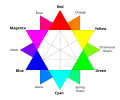
Salmon is a warm color ranging from light orange to pink, named after the color of salmon flesh.
Contents
The first recorded use of salmon as a color name in English was in 1776. [1]
The actual color of salmon flesh varies from almost white to light orange, depending on their levels of the carotenoid astaxanthin, which in turn is the result of the richness of the fish's diet of krill and shrimp; salmon raised on fish farms are given non-synthetic or artificial coloring in their food. [2] [3]
The flesh of Atlantic salmon (Salmo salar) is lighter and oranger than that of the various Pacific salmon species (from the genus Oncorhynchus). [4]

